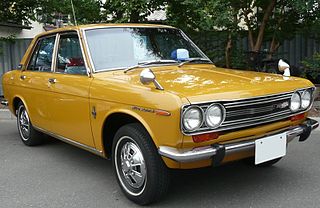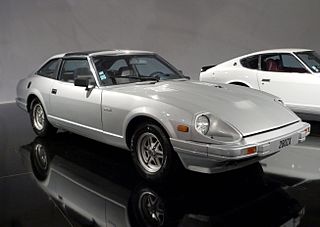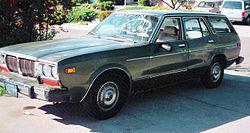
The Nissan Maxima is a full-size car manufactured by Nissan and sold primarily in North America, the Middle East, and China. Making its sales debut in 1981 for the 1982 model year as the Datsun Maxima, it replaced the earlier Datsun 810. The name "Maxima" dates back to 1980 for the 1981 model year when the upscale 810 sold as the "810 Maxima" in North America. Like the 810, early versions of the Maxima had their origins in the Datsun/Nissan Bluebird. The Datsun brand was phased out in favor of Nissan in 1984 for the 1985 model year, thus becoming the Nissan Maxima.

The Pontiac Sunbird is a small car manufactured and marketed by Pontiac over two generations.

The Datsun 510 was a series of the Datsun Bluebird sold from 1968 to 1973, and offered outside the U.S. and Canada as the Datsun 1600.

The Nissan Violet appeared in Japan in 1973, and was exclusive to Japanese Nissan dealerships called Nissan Cherry Store as a larger companion to the Nissan Cherry.

The Mazda Luce is an executive car that was produced by Mazda in Japan from 1969 until 1991. It was widely exported as the Mazda 929 from 1973 to 1991 as Mazda's largest sedan. Later generations were installed with luxury items and interiors as the Luce became the flagship offering. The Luce was replaced by the Sentia in 1991 which was also exported under the 929 name. The name "luce" was taken from the Italian word for "light".

The Ford Fairmont is a compact car that was produced by Ford for the US and Canada markets for the 1978 to 1983 model years. The debut of the Fairmont and its Mercury Zephyr counterpart marked the launch of the long-running Ford Fox platform that would underpin twelve additional models and stay in production until 1993. Offered in a variety of body styles, the Fairmont succeeded the Ford Maverick, and was replaced by the front-wheel drive Ford Tempo for the 1984 model year.

The Dodge Colt were subcompact cars manufactured by Mitsubishi Motors and marketed by Dodge for model years 1971-1994 as captive imports. Badge engineered variants included the Plymouth Champ and Plymouth Colt, marketed by Plymouth.

The Nissan Bluebird is a compact car with a model name introduced in 1957. It has been Nissan's most internationally recognized sedan, in multiple body styles, and is known for its dependability and durability. The Bluebird originated from Nissan's first vehicles, dating to the early 1900s, and its traditional competitor became the Toyota Corona. The Bluebird was positioned to compete with the Corona, as the Corona was developed to continue offering a sedan used as a taxi since Toyota Crown was growing in size. Every generation of the Bluebird has been available as a taxi, duties that are shared with base level Nissan Cedrics. It is one of the longest-running nameplates from a Japanese automaker. It spawned most of Nissan's products sold internationally, and has been known by a number of different names and bodystyles, including the 160J/710/Violet/Auster/Stanza line.

The Nissan S130 is a sports coupé produced by Nissan in Japan from 1978 to 1983. It was sold as the Datsun 280ZX, Nissan Fairlady Z and Nissan Fairlady 280Z, depending on the market. In Japan, it was exclusive to Nissan Bluebird Store locations. It was the second generation Z-car, replacing the Nissan S30 in late 1978. The 280ZX was the first time the "by Nissan" subscript was badged alongside the Datsun logo, along with Nissan trucks. The 280ZX was Motor Trend's import car of the year for 1979. The 280ZX was replaced by the Nissan 300ZX in 1984.

The Nissan Sunny is an automobile built by the Japanese automaker Nissan from 1966 to 2006. In the early 1980s, the brand changed from Datsun to Nissan in line with other models by the company. Although production of the Sunny in Japan ended in 2006, the name remains in use in the Chinese market for a rebadged version of the Nissan Latio.

The Subaru Leone is a compact car produced by the Japanese car manufacturer Subaru from 1971 to 1994. The word leone is Italian for lion.

The Nissan Pulsar is a subcompact and compact car produced by the Japanese automaker Nissan from 1978 until 2000, when it was replaced by the Nissan Bluebird Sylphy in the Japanese market. Between 2000 and 2005, and then since 2012, the name "Pulsar" has been used in Australia and select Asian countries on rebadged versions of the Sylphy and similar Tiida model. In 2014, a European-only replacement for the Tiida was introduced using the Pulsar nameplate.

The Toyota Mark II is a mid-size sedan manufactured and marketed in Japan by Toyota between 1968 and 2004. Prior to 1984, the model was marketed as the Toyota Corona Mark II. In some export markets, Toyota marketed the vehicle as the Toyota Cressida between 1976 and 1992 across four generations. Toyota replaced the Cressida in North America with the Avalon. Every Mark II and Cressida was manufactured at the Motomachi plant at Toyota, Aichi.

The Nissan L series of automobile engines was produced from 1967 through 1986 in both inline-four and inline-six configurations ranging from 1.3 L to 2.8 L. This was the engine of the dependable Datsun 510, iconic Datsun 240Z sports car, and debut upscale Nissan Maxima. These engines are known for their extreme reliability, durability, and parts interchangeability. It is a two-valves per cylinder SOHC non-crossflow engine, with an iron block and an aluminium head. The four-cylinder L series engines were replaced with the Z series and later the CA series, while the six-cylinder L series engines were replaced with the VG series and RB series.

The Nissan Z engine is a series of automobile and light truck engines that was engineered by Nissan Machinery, manufactured by the Nissan Motor Company from 1979 through August 1989. All Z engines had 4 cylinders, a total of 8 valves and a single overhead camshaft (SOHC). Displacements ranged from 1.6 L to 2.4 L.The Z series' engine blocks were nearly identical to those of the earlier L Series with the exception of the Z24. While the Z16 and Z18 engines had a deck height similar to the earlier L13/L14/L16/L18 variants, the Z24 had a taller deck height to accommodate a longer stroke. The most notable difference between the Z-series engine and its predecessor was the introduction of a new crossflow cylinder head which reduced emissions by moving the intake ports to the right side of the engine opposite the exhaust ports. This change allows the exhaust port velocity to more effectively scavenge the cylinder and reduce reversion pulses to enhance induction. The Z series evolved into the NA and KA engines which, along with the smaller CA series, replaced the Z series.

The Nissan Cedric is a large automobile produced by Nissan since 1960. It was developed to provide upscale transportation, competing with the Prince Skyline and Gloria which were later merged into the Nissan family. In later years, the Nissan Skyline was positioned as a sports sedan/coupe, whereas the Nissan Gloria was turned into a sporty version of the Cedric.

The Datsun Cherry (チェリー), known later as the Nissan Cherry, was a series of subcompact cars which formed Nissan's first front-wheel drive supermini model line.

The Ford Granada is a range of mid-size sedans that was manufactured and marketed by Ford in North America. Introduced for the 1975 model year as the intended successor of the Ford Maverick, two generations of the Granada were sold through the 1982 model year. Sharing its name with the flagship sedan of Ford of Europe, the Granada was slotted above the Maverick as a luxury compact vehicle, expanding the segment in the United States.

The Corolla E30/E50 was the third generation of cars sold by Toyota under the Corolla nameplate. It was built from August 1974 to July 1981 and marked Toyota's greatest growth in the United States in the wake of the fuel crisis. In addition to its sister model, the Sprinter, there was a redesigned-body version built by Toyota affiliate Daihatsu, called the Daihatsu Charmant. While there were certain fourth-generation models with a longer model life, this generation, when considered as a whole, was the longest-lived one, possibly due to the worldwide recession in the 1970s. A large range of cars were built using this chassis, including Corollas, Sprinters, Daihatsu, and the sporty Levin and Trueno models with the DOHC motor, with a fuel injection upgrade added to Japanese Levin models in January 1977.

The Datsun Bluebird (910) is an automobile which was produced by Nissan from 1979 to 1984.
























